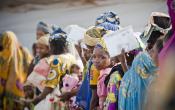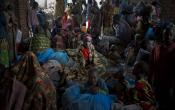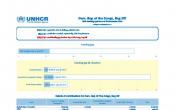Democratic Republic of the Congo Regional Office
Operation: Democratic Republic of the Congo Regional Office
Location
{"longitude":22,"latitude":-4,"zoom_level":5}
Latest update of camps and office locations 21 Nov 2016. By clicking on the icons on the map, additional information is displayed.
Key Figures
| 2017 planning figures | |
| 287,380 | people of concern will receive production kits or materials for agriculture, livestock or fishery activities (250,000 internally displaced people and 37,380 refugees) |
| 45,400 | people of concern will be provided with transport in order to return to their homes |
| 23,200 | refugee children will be enrolled in primary school |
| 8,800 | refugees will receive transitional shelters |
| 750 | survivors of sexual and gender-based violence (SGBV) will receive medical assistance |
| 2015 end-year results | |
| 133,000 | protection incidents were recorded in 2015, of which 10,400 were related to sexual and gender-based violence (SGBV) |
| 78% | of Burundian refugee children were enrolled in primary education |
| 45% | of CAR refugee children were enrolled in primary education |
| 45% | of CAR refugees had access to latrines |
| 33% | of Burundian refugees had access to latrines |
| 74% | of Burundian refugees resided in adequate dwellings, while shelter and infrastructure were improved and maintained |
| 97% | of CAR refugees resided in adequate dwellings, while shelter and infrastructure were improved and maintained |
Latest Updates and Related Links
Last Updated 29 November 2016
People of Concern
25%
Decrease in
2015
2015
| 2015 | 2,701,921 |
| 2014 | 3,619,785 |
| 2013 | 3,817,537 |

[["Refugees",384038],["Asylum-seekers",2924],["IDPs",1555112],["Returned IDPs",736837],["Returned refugees",8536],["Others of concern",14474]]
Loading ...
Budgets and Expenditure for Democratic Republic of the Congo Regional Office
< Back
2015
{"categories":[2012,2013,2014,2015,2016,2017],"budget":[157.672624547,196.62741826,196.1200685,207.82899884,209.45817243,208.004607445],"expenditure":[76.25272289,80.44026164,82.89793508,81.24654248,null,null]}
{"categories":[2012,2013,2014,2015,2016,2017],"p1":[84.337626717,84.29544165,71.90779198,91.41104086,102.87590623,110.403334892],"p2":[1.02275178,1.76370934,1.64748057,2.69677526,1.923405,1.94889796],"p3":[22.3166671,24.57256446,47.12909081,38.54665211,29.81920304,29.87324604],"p4":[49.99557895,85.99570281,75.43570514,75.17453061,74.83965816,65.779128553]}
{"categories":[2012,2013,2014,2015,2016,2017],"p1":[43.22165176,48.3141246,50.09923907,57.35459999,null,null],"p2":[0.51723528,1.40268682,0.79246867,0.72133408,null,null],"p3":[8.24604447,12.22476921,16.65508797,10.2698795,null,null],"p4":[24.26779138,18.49868101,15.35113937,12.90072891,null,null]}
Loading ...
CHOOSE A YEAR
- 2014
- 2015
- 2016
- 2017
Working environment
The volatile security situation in eastern Democratic Republic of the Congo (DRC) in late 2016 was further compounded by the delay of the Presidential elections. The ongoing climate of instability in parts of the country could pose serious challenges to UNHCR’s ability to implement the required level of protection and assistance for people of concern in 2017. Military operations in the Kivu region and localized conflicts with armed groups are expected to continue in 2017. Developments in neighbouring countries such as South Sudan and Burundi may also lead to further refugee influxes.The Government of DRC is providing land for the establishment of refugee camps, as well as contributing to the security in the camps, civil status documentation and registration exercises. Refugee children are able to enroll in schools.
Key priorities
In 2017, UNHCR’s protection strategy will continue to be oriented towards durable solutions while ensuring the centrality of protection in all interventions. The strategy will focus on building self-reliance, with a view to empowering people of concern while strengthening the resilience of entire communities.In 2017, UNHCR’s operation will focus specifically on:
• multi-sectoral assistance to camp-based refugees alongside the promotion of alternatives to camps;
• building self-reliance by supporting livelihood opportunities for refugees and host communities;
• facilitating durable solutions, including voluntary returns of refugees in DRC and of Congolese refugees in neighbouring countries.
• Protection monitoring, prevention of and response to SGBV and search for durable solutions for the 1.7 million IDPs in the country.
In the event of a funding shortfall in 2017, primary education for both people of concern and host communities, provision of transitional shelters, medical assistance to SGBV victims, and provision of production kits to people of concern will be affected.






